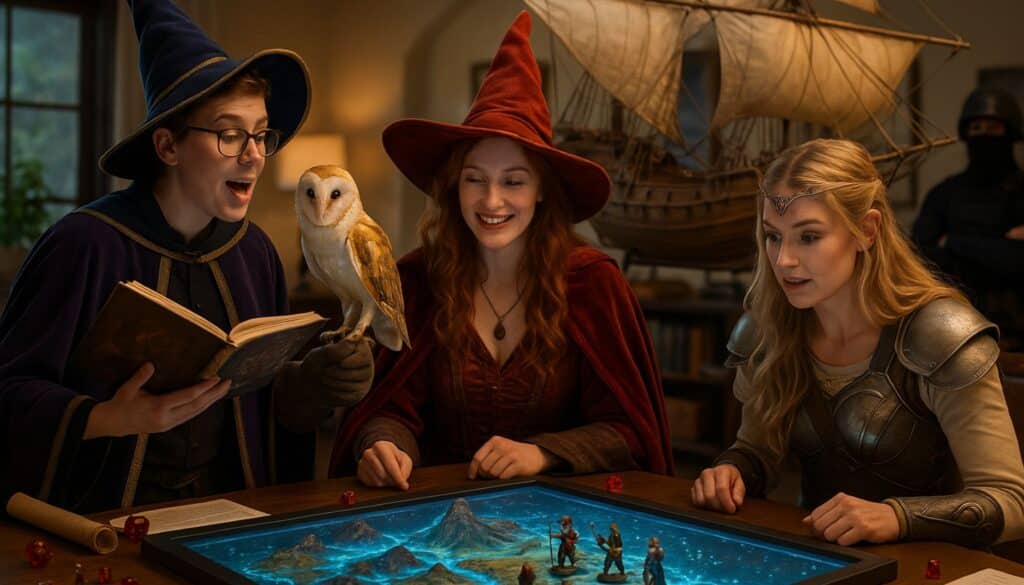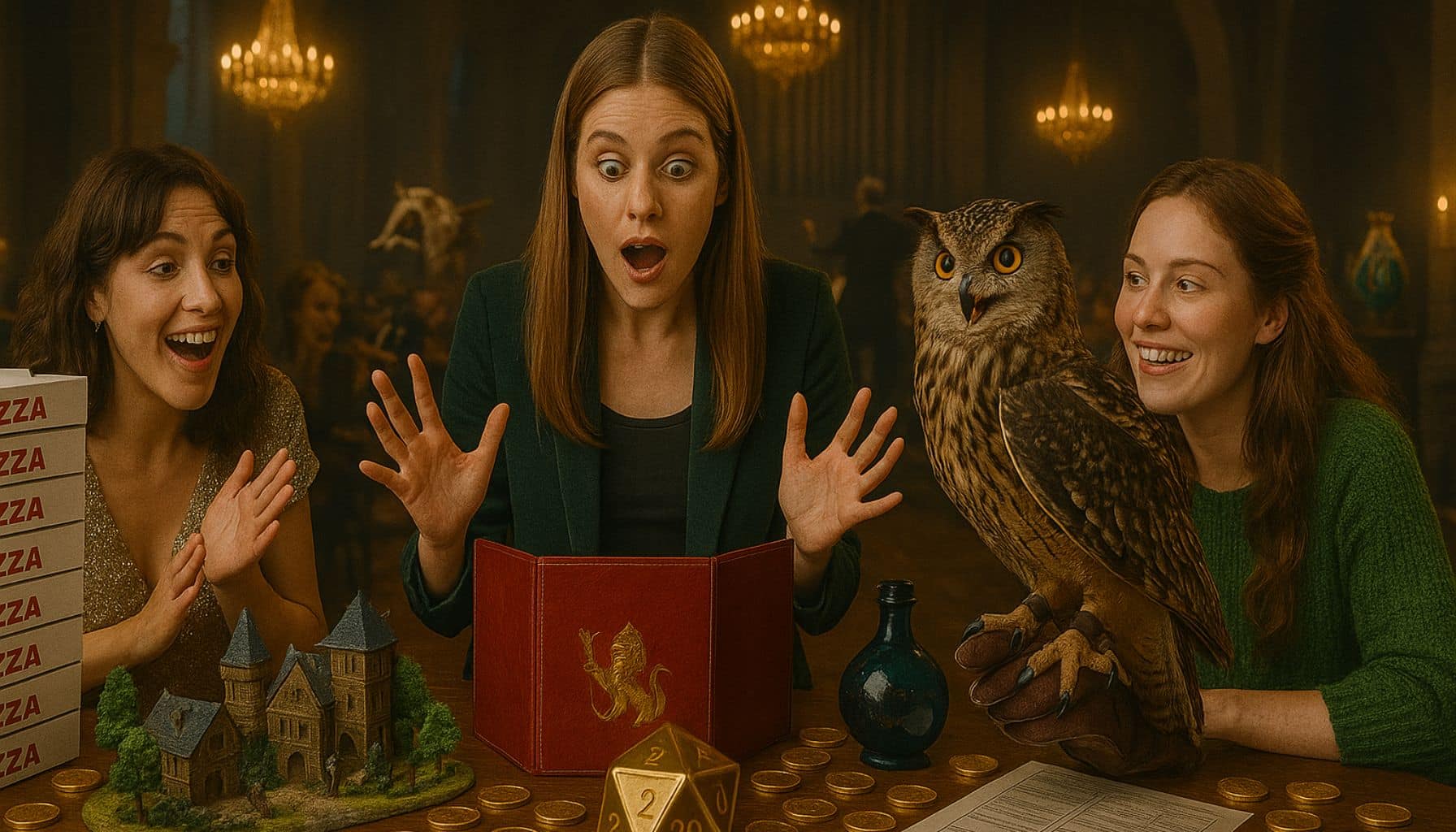Not a real campaign. Not real people. Just real dumb jokes.
I want to begin with a heartfelt promise: this was always meant to be just a casual homebrew game night. Nothing fancy. Just a handful of friends, some mismatched dice, maybe a bowl of chips, and detailed notes on which of us was allergic to plastic cheese dust. Our ambitions were humble. We had dreams of slaying dragons, not budgets. But somewhere along the way, we collectively agreed—very seriously, with finger steepling—that “pedestrian” wasn’t an option for true fantasy immersion. Why scribble on graph paper when you can project the burning steppes of a volcanic wasteland in 4K Ultra HD onto your table? Why settle for basic snacking when one could commission a chef specializing in medieval charcuterie boards? These were the questions that changed everything.
The first escalation was relatively innocent. Someone—maybe the druid—muttered that our game night deserved better acoustics. After all, how could a cleric’s sacred pronouncements echo properly from behind a couch? That’s why, two weeks later, we found ourselves renting a co-working space in a deconsecrated church. The vaulted ceilings added gravitas to every “Guiding Bolt,” and the stained glass filtered the afternoon sun with all the drama of a B-list gothic vampire film set. We told ourselves this was temporary, just a phase, not a harbinger of doom. We were hilariously wrong. (It’s why we offer a free fantasy name generator now!)
It was only a matter of time before one player commented that all our NPCs sounded suspiciously alike, like regional managers at a suburban Applebee’s. The solution was obvious: hire dialect coaches. Not ones with cheap accents, either—these were former West End performers and PhDs, ready to teach the party how to snarl in Draconic or bargain in fluent Sylvan. Our human fighter developed a surprisingly good Dwarvish lilt. Things spiraled from there when our linguist friend got roped in and, for a not-inconsiderable fee, constructed a fully functional goblin language for NPCs and party members alike. Suddenly even minor tavern scenes demanded subtitles and vocal warm-ups.
But why stop at language when the physical world itself was held together with duct tape and dry-erase ink? We knew we needed battlemaps worthy of our vision quests. Licensing drone footage of Iceland became the obvious solution. Every combat encounter morphed into a cinematic masterpiece with volcanoes smoking on the table and glacial rivers trickling past the dice. To display these marvels in their full majesty, we procured a 4D holotable. Anything less would have risked breaking the all-important “authenticity” contract with our inner children (and outer wallet).
The logic for each new expense was compelling—almost chilling in its rationality. For instance, player immersion required costumes. Not just any costumes, but garments hand-selected by tailors who specialized in historical wizard robes, with obsessive attention paid to things like “period-accurate thread count.” Each player received a $6,000 stipend to ensure their sartorial splendor. Our rogue gleefully spent most of his on boots made from “ethically sourced” wyvern hide, and the warlock discovered a London-based milliner whose hats could double as spell components.
Meanwhile, the dungeon master’s role had grown from humble referee to full-blown ringmaster of a miniature cinematic universe. She needed a prep room, obviously, but the minimum specs included a cryo-cooled server rack running not one, but three AI Dungeon Designer assistants. In one corner sat an emotional narrative consultant, ready to coach players through particularly fraught intra-party betrayals, while a freelance Jungian archetype analyst hovered nearby with copious notes on the wizard’s emerging shadow complex. Nobody was allowed to simply “wing it” anymore.
Try my AI Tabletop RPG generators...and an extensive library of content!
Downtime between sessions couldn’t just be narrated when true method immersion beckoned. When the party wanted to blacksmith or mix potions, we simply booked the nearest available Tuscan villa, conveniently adjacent to a world-class herbal garden and blacksmithing studio. There, our paladin learned to forge a real broadsword (while marinating a rosemary chicken), and the ranger developed an unexpected passion for artisanal soaps. These were not merely character-building exercises; these were “necessary expenses for the art.”
Leveling up was now an event. Gone were the days of ticking a box and adding one to your THAC0. Instead, player characters attended intensive, invitation-only bootcamps, run by stunt choreographers who insisted on real sword fighting, shield bashing, and “method” death scenes. Every feat unlocked required sweat, tears, and, on one memorable occasion, a trip to urgent care for a sprained bard. The DM hired a medieval falconer just to simulate the wizard’s new “familiar” at level five, resulting in at least three stained tunics and a lifelong distrust of all owls.

All of this, naturally, attracted the attention of the influencer crowd. Soon, our sessions weren’t streamed for free on Twitch—they were exclusive to a blockchain-gated NFT platform where access required both an invite and an obscure crypto token. Each player donned a motion capture suit lined with dynamic LED face rigs, capturing every twitch of the paladin’s lower lip and every hesitant glance between the bard and the innkeeper. One needed three separate apps to reliably watch, and even then, half the fanbase demanded “Toggle Off Bard Soft Lighting” patches.
To provide the emotional nuance our audience demanded, we spared no expense. The wizard’s familiar—once a plush owl—was replaced by a live, fully-trained owl whose handler commuted weekly from Vancouver. The owl’s contract contained more dietary stipulations than most of our player agreements. Whenever the owl was unavailable, a sock puppet stood in, which, according to some, had “more charisma than the fighter.”

Fantasy RPG AI Generators with ChatGPT+
Make life as a Game Master easier.... If you play Dungeon & Dragons, Pathfinder, or other fantasy tabletop role-playing games, check out my DND character backstory generator and other fine AI RPG tools at LitRPG Adventures Workshop today.
The bard’s passion for music quickly became a running joke and financial drain. He wouldn’t sing to mere Spotify tracks. Instead, he issued weekly demands for original compositions performed live by a rotating panel of guest composers. Rumor buzzed that one of them was, in fact, a robot modeled after Andrew Lloyd Webber. When the robot misunderstood a brief about “musical tension,” we wound up with an entire battle underscored by a polka mashup of Phantom of the Opera and The Lion King.
Not that we ever questioned the costs. Every new line item was justified in solemn tones. “Can we really simulate what it’s like to storm an airship if we just… describe it?” The answer, of course, was a resounding no. Thus, the airship was built, full-sized, suspended from a crane above our playing space, complete with a subwoofer array that rattled the entire co-working space with every rumble of liftoff. One neighbor reported “feeling the campaign’s emotional journey through her floorboards.”
Even random encounters deserved the gold standard—describing a goblin ambush was considered gauche. Instead, we hired a troupe of improv comedians who would leap out of closets and stairwells at unpredictable moments, pelting us with rubber arrows and philosophical riddles on the nature of loot. One night, the barbarian was tackled mid-toilet break by a halfling dressed as a dire raccoon. You haven’t lived until you’ve rolled initiative while wearing a face mask and holding a Capri Sun.
Risk refused to confine itself to our character sheets. One fateful evening, disaster struck not because of a botched dice roll, but due to a surprise insurance audit. Mid-session, a sharp-suited auditor announced that our cleric’s spellcasting constituted “unauthorized religious consulting,” immediately voiding our resurrection clause and resulting in a campaign-ending technical Total Party Kill. Even the bard’s robot composer looked crestfallen.

Chaos, it turns out, requires an army of managers. Soon, our campaign had a standing legal counsel—an expert in interplanar intellectual property law, capable of arbitrating disputes over whether a homebrewed spell counted as derivative or transformative. There were sessions featuring nothing but cross-examination about spellcasting copyrights and trademarked holy symbols. At one point, the lawyer attempted to unionize the goblins.
Continuing beyond the law, we had a team of full-time continuity editors, their only task the maintenance of plotlines, family trees, and the ever-evolving relationships among the NPC extras. These unsung heroes operated a timeline-chart so large it required a dedicated segment of the holotable. Whenever the bard’s tragic love affair overlapped with the villain’s redemption arc, a red light flashed, summoning the editors to mediate—armed, presumably, with color-coded sticky notes and energy drinks.
No campaign gimmick was too small for bureaucracy. To prevent spoilers, all players had to sign non-disclosure agreements before every session. These were reviewed by outside counsel and typically included clauses against “neckbeard leaks” and “emotional theft.” Half the party now receives promotional emails about zero-knowledge cryptography between announcements about the rogue’s new multilevel marketing career.
And then there was the matter of “atmospheric extras.” Whenever we ventured into populous villages, a local talent agency provided a nearly endless parade of costumed peasants, surly bartenders, and sacred cows. Unfortunately, about half of them were convinced they were filming a gritty medieval soap opera, so background scenes routinely included overheard dialogue like, “Sir Chadwick, your betrothed suspects the apothecary’s potion!” Some of these NPC subplots outlasted actual player characters.
The extras, as it turned out, threatened to unionize and demand their own spinoff, but that was beyond our production budget—in theory. Stage directions and impromptu soliloquies became common background noise. No one dared complain; there was a sense we were witnessing theater, even if it was just happening behind the figurines and in front of the snack table.
Simply playing D&D became a matter of contract negotiation. Meta-gaming, once punished with withering DM glares, now carried an $800 fine. Players appealed infractions before a stern-faced tribunal composed of the DM, the legal advisor, and a rotating panel of hired improv comedians. Occasionally, a minor infraction led to a repeat performance, complete with multiple camera angles and postgame analysis.
The rogue, always quick with a loophole, found himself tripped up by tax law. Upon looting a chest, he was required to file a 1099 form with the campaign’s in-house accountant. The barbarian, flush with treasure and confusion, once tried to deduct a +1 greataxe as a “capital loss” after it was destroyed (the request is still pending IRS review).

Fantasy RPG AI Generators with ChatGPT+
Make life as a Game Master easier.... If you play Dungeon & Dragons, Pathfinder, or other fantasy tabletop role-playing games, check out my DND character backstory generator and other fine AI RPG tools at LitRPG Adventures Workshop today.
Of course, the final boss fight could never be contained by mere imaginations and quiet dice-rolling. Instead, it took place on a stage before a live audience of 200 hand-selected fans, each flown in via private shuttle and treated to the kind of culinary experience typically reserved for actual royalty. Wenches (with union cards and period dialogue coaches) served roasted pheasant and frothy ale in pewter flagons. The audience was required to stay in-character throughout, and at least four viewers attempted to cast Minor Illusion before dessert.
The production’s fever dream was briefly interrupted when we attempted to tally our gains against our losses. Our collective moments of awe and wonder became increasingly hard to spot beneath the deluge of invoices, insurance forms, and meticulously sorted costume receipts. Our campaign’s most emotionally resonant moment—a clunky, beautiful reconciliation between two estranged siblings—was ruined not by poor acting, but by the DM’s lapel mic picking up the gastric tumult of the wizard’s nutritionist in the next room.
This was all reshot, of course. Lighting was calibrated to reflect the proper degree of melancholy, and the bard’s live pianist composed a minor key dirge on the spot. In the end, the only thing truly spontaneous was the accountant’s remark that “sibling reconciliation is over budget this quarter.” Our deepest narrative triumphs became scheduled, curated, and subject to final approval by the continuity team.
And yet, despite everything, we were left with stories we’d never quite forget. Those fleeting glimpses of real camaraderie amid the chaos, the joy of rolling a natural 20 as drone footage of Iceland thundered across the holotable’s surface, the adrenaline rush of arguing copyright law with a man in wizard robes, all proved there was something worth chasing in the madness.
I’d almost say it was worth it. Almost. But why stop at $500,000 when a truly legendary campaign deserves nothing less than a seven-figure budget? If you’re reading this, don’t settle for less. Dice are a relic—replace them with biometric sensors that track your heart rate, galvanic skin response, and pupil dilation to determine in-game success. This ensures that only those fully immersed stand a chance at passing their saving throws.
Battle fatigue? Skip it! Your post-game potions should arrive by drone, conveniently timed during the villain’s monologue. Don’t neglect your emotional health—schedule a session with a licensed therapy goat for post-boss-fight trauma processing. If your DM doesn’t offer a decompression retreat in Bali at campaign’s end, are you truly even roleplaying?
Let me leave you with the moral of the story: Dungeons & Dragons, at its heart, is not about fun, imagination, or shared story. It is about scalable intellectual property. It is about production value that demands respect—preferably from Emmy voters and tax consultants alike. If you’re not chasing trophies, invoices, or at least a trademark, you’re just playing pretend. Aim higher. Your goblin dialect coach and emotionally nuanced owl familiar are counting on you.
No, none of this really happened, but I saw another big D&D YouTuber talking about a $5,000 game! Haha. All in good fun!
D&D $500,000 Campaign Reimbursement Request Table
Below is a highly confidential (and totally fake) excerpt from the campaign’s official cost ledger, discovered in the Dungeon Master’s private Google Drive folder titled “Absolutely Necessary Expenses – Final FINAL.xlsx.” Please direct all reimbursement queries to the party’s Chief Financial Elf.
| Description | Vendor | Qty | Unit Price | Subtotal | Comments |
|---|---|---|---|---|---|
| Gothic church co-working rental | Sanctum Spaces | 14 | $3,000 | $42,000 | “Cleric’s echo request. Non-negotiable.” |
| Dialect coach (NPC accents) | Prestige ProVox | 6 | $1,200 | $7,200 | Includes crash course in “Dwarvish Cockney.” |
| Functional Goblin language development | Dr. T. Vernacular, PhD | 1 | $28,000 | $28,000 | All goblin profanity rigorously peer-reviewed. |
| Custom battlemaps (Iceland drone footage) | Glacialis Media Group | 7 | $4,500 | $31,500 | Scenic volcanoes extra. |
| 4D holotable rental/installation | Verisimilitech | 1 | $47,000 | $47,000 | Pepperoni pizza banned from vicinity. |
| Costume stipend per player | Attire of Ages | 5 | $6,000 | $30,000 | Rogue demanded real mithril thread. |
| Personal wizard robe tailoring | Madam Sable’s Mystical Haberdashery | 3 | $3,200 | $9,600 | Hand-washed in moonwater. |
| Emotional narrative consultant | The Subtext Collective | 1 | $11,000 | $11,000 | Refused payment in “exposure.” |
| AI Dungeon Designer (monthly) | NeuralDice Labs | 3 | $6,000 | $18,000 | One AI specializes in sentient tavern furniture. |
| Jungian archetype analyst | ShadowSelf Analytics | 1 | $4,000 | $4,000 | Identified four players as “The Fool.” |
| Tuscan villa blacksmithing retreat | La Villa del Ferro | 5 | $6,800 | $34,000 | No Wi-Fi. An outrage. |
| Combat bootcamp w/ pro stunt choreographers | Sword & Board Productions | 5 | $10,500 | $52,500 | Paladin sprained ego. |
| Owl familiar handler (Vancouver flights) | Hoot Handoff Intl. | 8 | $2,175 | $17,400 | Wizard allergic to feathers. |
| Guest composer, session score (per week) | Symphonic Roll Initiative Collective | 13 | $1,800 | $23,400 | AI “Web-bot” only accepted payment in crypto. |
| Airship set construction and rigging | Skyward Realities | 1 | $63,000 | $63,000 | Subwoofers rated for dragon landings. |
| Improv comedian “random encounter” team | Sudden Laughter Troupe | 16 | $550 | $8,800 | Rare mimic closet. Charges double. |
| Legal counsel, interplanar disputes | & Sons, Esqs. | 1 | $12,500 | $12,500 | Negotiated goblin copyright cease-and-desist. |
| Continuity editors (seasonal retainer) | Timeline Integrity Mgmt. | 3 | $7,800 | $23,400 | Kept notes on every side quest chicken. |
| Extras casting for village scenes | Middle Ages Talent | 22 | $375 | $8,250 | Twelve thought it was for a BBC drama. |
| Michelin-starred catering, live finale | Feast of Realms | 200 | $325 | $65,000 | “Ale and truffle risotto night.” |
| NDA print/run fees (per session) | Absolute Discretion Printing | 32 | $45 | $1,440 | Printed on faux-dragonhide. |
Grand Total: $508,990 (and not a single copper piece less, as proven by six independent auditors and one very nervous intern)

